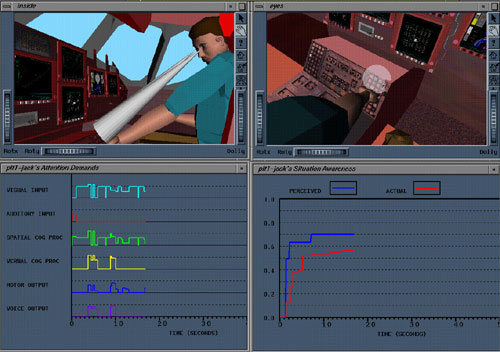 |
 |
 |
|
|
 |
|
| |
|
|
|
|
|
| |
SHUTTLE
MIDAS
-
Initial
Cockpit
Upgrade
for
the
Space
Shuttle
Vehicle |
| |
|
|
|
|
|
| |
The
Ames
Shuttle
Cockpit
(ASC)
Upgrade
team
has
been
involved
in
a
Johnson
Space
Center
(JSC)-led
cockpit
re-design
effort
focussing
on
the
presentation
of
information
to
the
astronauts
during
critical
phases
of
flight.
This
coordinated
effort
between
NASA
Ames
Research
Center
(ARC) and
JSC
is
aimed
at
improving
the
current
Space
shuttle
displays
to
enhance
the
crew’s
situation
awareness.
The
current
Caution
&
Warning
(C&W)
system
is
currently
non-intuitive
and
spread
over
a
variety
of
different
systems.
There
is
no
centralized
single
point
failure
identification
available
for
crew.
Annunciator
panel
lights,
fault
messages,
systems
displays,
and
parameter
status
indicators
must
in
some
cases
be
pieced
together
to
determine
what
the
failure
is.
All
of
this
results
in
information
overload.
Meanwhile,
the
system
displays
are
difficult
to
decipher,
requiring
considerable
training,
extensive
signature
recognition
skills
and
conversion
of
data
to
useful
information.
Guidance,
Navigation
and
Control
(GNC)
displays
are
poor
and
automatically
change
without
warning,
and
data
is
scattered
throughout
the
flight
deck.
Finally,
there
is
no
warning
or
guidance/autopilot
limiting
when
approaching
a
stall
on
entry.
The
Shuttle
Upgrade
Program
was
created
to
reduce
these
cockpit
display
problems
by
designing
a
new
generation
of
cockpit
displays.
The
primary
design
goals
are
to:
*
Reduce
crew
workload
*
Increase
crew
vehicle
and
systems
SA
*
Enhance
Crew
Resource
Management
*
Increase
flight
crew
autonomy
*
Computer
assist
or
automate
complex
procedures
In
order
to
evaluate
the
design
effect
on
human
performance,
the
ASC
Upgrade
team
prepared
a
MIDAS
human
performance
model
designed
to
quantify
the
workload
effects
of
the
changes
in
the
display
technology
being
introduced.
The
current
modeling
effort
resulted
in
a
dynamic
simulation
of
the
human
agent
JACK
as
he
interacts
with
the
new
display
suite.
Click
on
the
movie
below
to
download
the
MIDAS
movie.
|
| |
| |
|
|
|
|
|
| |

Shuttle
MIDAS
-
MIDAS
Screen
Layout
(click
here
for
scenario
description)
|
Shuttle
MIDAS
-
MIDAS
Screen
Layout
-
In
this
scenario
we
see
four
screens
(called
viewer
windows)
related
to
an
operator
agent's
environment
(MIDAS
has
implemented
JACK®
as
the
agent
operator
in
this
instantiation).
There
are
four
viewer
windows
in
this
scenario
of
the
agent
as
he
monitors
the
cockpit
of
the
Space
Shuttle.
Starting
in
the
top
left,
we
can
see
a
window
of
the
agent's
profile
and
crewstation
as
he
visually
scans
the
interior
environment.
The
top
right
screen
demonstrates
the
view
from
the
agent's
eyes.
This
screen
demonstrates
the
operator
agent's
interior
visual
scan
pattern
and
fixation
points.
Changes
in
the
environment
get
encoded
by
the
agent
and
update
the
world
representation
if
the
information
falls
within
his
attention
cones.
These
changes
also
trigger
workload
associated
with
respective
tasks
and
procedures
that
the
agent
is
performing.
The
bottom
right
screen
indicates
the
workload
output
along
a
six-channel
representation
of
workload
as
the
agent
deals
with
the
environmental
events.
The
six
channels
of
workload
include
visual
input,
auditory
input,
spatial
cognitive
processing,
verbal
cognitive
processing,
motor
output,
and
voice
output.
The
bottom
left
viewer
window
demonstrates
the
agent's
Situation
Awareness
(SA).
This
is
calculated
by
taking
a
calculation
(ratio)
of
perceived
SA
versus
actual
SA.
Generally
speaking
this
perceived
will
be
lower
than
the
actual
SA
as
the
theory
upon
which
this
is
based
indicates
that
people
generally
think
they
know
more
about
their
surroundings
than
they
actually
do
know
(see
Shively,
Brickner
&
Silbiger,
1997).
|
|
|
| |
POC-
Rob McCann |
|
|
|
|
| |
|
|
|
|
|
|
|
|
